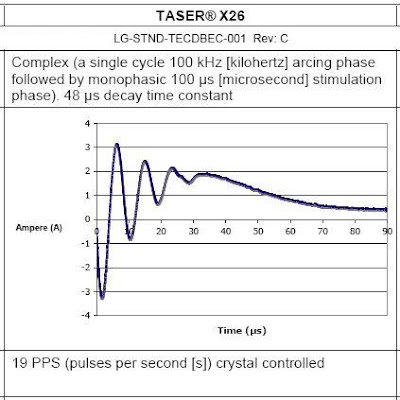The M26 taser, introduced in 1999, used a waveform that was a damped sinewave at 50kHz.
 M26 Waveform
M26 WaveformThe result of using a waveform that is more-or-less symmetrical about the zero amp axis is that the frequency spectrum remains clean and high (50 kHz) and the duration of each pulse remains short. And thus Kroll can claim the chronaxie safety factor as well as the improved safety margin of the 50 kHz high frequency.
 M26 Spectrogram (guesstimated)
M26 Spectrogram (guesstimated)X26 taser, introduced in 2003
In 2003, Taser introduced the X26. The X26 waveform is similar to the M26 waveform at the outset with the arc phase, but it includes a very significant difference on the right hand side: a long and low monophasic pulse. This is extremely significant.
 X26 Waveform
X26 WaveformThis long and low monophasic (DC) pulse generates (actually is) the low frequency spectral component at the pulse repetition frequency of 19 Hz. Because this 19 Hz component is not a sinewave, it is heavily laced with harmonics of 19 Hz (38 Hz, 57 Hz, and many many more).
 X26 Waveform Annotated
X26 Waveform AnnotatedSo the X26 waveform contains a significant low frequency component. It isn't just short pulse of high frequency anymore as it was with the older M26.
 X26 Spectrogram (guesstimated)
X26 Spectrogram (guesstimated)And those more-dangerous low frequency components are continuous 100% duty cycle for the entire 5-second cycle.
Conclusions
None of this means that the older M26 taser is without risk.
The primary takeaway points are as follows:
- The X26 waveform is more-dangerous low frequency at 19 Hz.
- The X26 waveform is more-dangerous continuous 100% duty cycle for the entire 5-second cycle.
- Kroll's theory about the chronaxie safety factor probably doesn't apply to the X26.
2003
The X26 was introduced in 2003.
Here is a graph of the taser-associated deaths by month as listed on the Truth...Not Tasers blog. [LINK]
 Taser-associated deaths by month
Taser-associated deaths by month2003 is roughly mid-graph (where the taser-associated death rate begins to shift to a much higher value).
Chronaxie
Because Taser and Kroll continue to talk about the safety factor of short pulses and chronaxie, it is my opinion that they have not made this connection from the 19 Hz low frequency component of the X26 waveform, to it therefore being continuous 100% duty cycle (where chronaxie probably wouldn't apply).
I do not believe that the significance of this observation to the taser-safety issue can be overstated.
And I cannot see any escape from the conclusions.

No comments:
Post a Comment